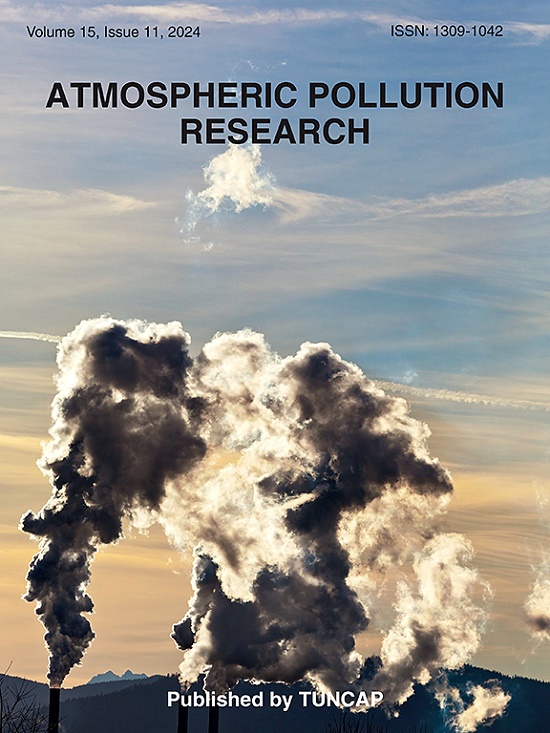越南北部海防市和河内市气溶胶中的颗粒物质和碳含量
IF 3.5
3区 环境科学与生态学
Q2 ENVIRONMENTAL SCIENCES
引用次数: 0
摘要
通过对越南北部两个主要城市海防和河内的大气颗粒物(PM)及其碳质含量(元素碳、EC和有机碳、OC,包括多环芳烃,PAHs)的调查,旨在阐明当地和区域大气污染的相对重要性。2020-2023年,海防市和河内市PM2.5的月平均范围分别为14 ~ 37 μ m−3和35 ~ 102 μ m−3。海防PM10中EC、OC和PAH的年平均浓度分别为2.1±1.3 μ m−3、4.9±3.1 μ m−3和4.4±2.6 ng m−3,河内市PM2.5中EC、OC和PAH的年平均浓度分别为1.3±0.9 μ m−3、9.1±6.2 μ m−3和5.9±5.8 ng m−3。观察到季节变化,旱季(冬季)的数值高于雨季(夏季),这是根据季风气象条件所预期的。然而,EC、OC和PAHs之间的空间变化和相关性,以及人类活动的其他标记物(如左旋葡聚糖、二次无机气溶胶和金属),强调了当地排放源与从远处输送的排放源对城市的特定影响。城市化程度高的河内似乎每年都以当地排放量为主,而城市化程度较低且位于海边的海防则可以突出排放来源的季节性变化。虽然PM值超过了国际空气质量建议值的15倍,但与吸入多环芳烃有关的健康风险评估,与以往依赖金属的结果一致,仍然处于低至中等水平。本文章由计算机程序翻译,如有差异,请以英文原文为准。
Particulate matter and carbonaceous content in aerosols from Haiphong and Hanoi cities, Northern Vietnam
Airborne particulate matter (PM) and its carbonaceous content (elemental carbon, EC and organic carbon, OC, including polycyclic aromatic hydrocarbons, PAHs) were investigated in Haiphong and Hanoi, two major cities in the Northern Vietnam, aiming at elucidating the relative importance of local and regional atmospheric pollution. The monthly average ranges of PM2.5 were 14–37 μg m−3 in Haiphong, and 35–102 μg m−3 in Hanoi, respectively, during the period 2020–2023. EC, OC and PAH concentrations annually averaged 2.1 ± 1.3 μg m−3, 4.9 ± 3.1 μg m−3 and 4.4 ± 2.6 ng m−3 in Haiphong PM10 from Oct. 2012 to Oct. 2013, and 1.3 ± 0.9 μg m−3, 9.1 ± 6.2 μg m−3 and 5.9 ± 5.8 ng m−3 in Hanoi PM2.5 from Oct. 2019 to Dec. 2020, respectively. Seasonal variations were observed, with higher values during the dry season (winter) compared to the wet season (summer), as expected according to monsoon meteorological conditions. However, spatial variations and correlations between EC, OC, and PAHs, along with other markers of human activities (such as levoglucosan, secondary inorganic aerosols and metals), emphasized city-specific influence of local emission sources versus those transported from distant locations. Hanoi, highly urbanized, appeared to be yearly dominated by the local emissions while Haiphong, less urbanized and located near the sea, allowed to highlight seasonal variations in emission origin. While PM values exceeded up to 15 times international air quality recommendations, health risk assessment related to inhaled PAHs, in line with previous results relying on metals, remained low to moderate.
求助全文
通过发布文献求助,成功后即可免费获取论文全文。
去求助
来源期刊

Atmospheric Pollution Research
ENVIRONMENTAL SCIENCES-
CiteScore
8.30
自引率
6.70%
发文量
256
审稿时长
36 days
期刊介绍:
Atmospheric Pollution Research (APR) is an international journal designed for the publication of articles on air pollution. Papers should present novel experimental results, theory and modeling of air pollution on local, regional, or global scales. Areas covered are research on inorganic, organic, and persistent organic air pollutants, air quality monitoring, air quality management, atmospheric dispersion and transport, air-surface (soil, water, and vegetation) exchange of pollutants, dry and wet deposition, indoor air quality, exposure assessment, health effects, satellite measurements, natural emissions, atmospheric chemistry, greenhouse gases, and effects on climate change.
 求助内容:
求助内容: 应助结果提醒方式:
应助结果提醒方式:


